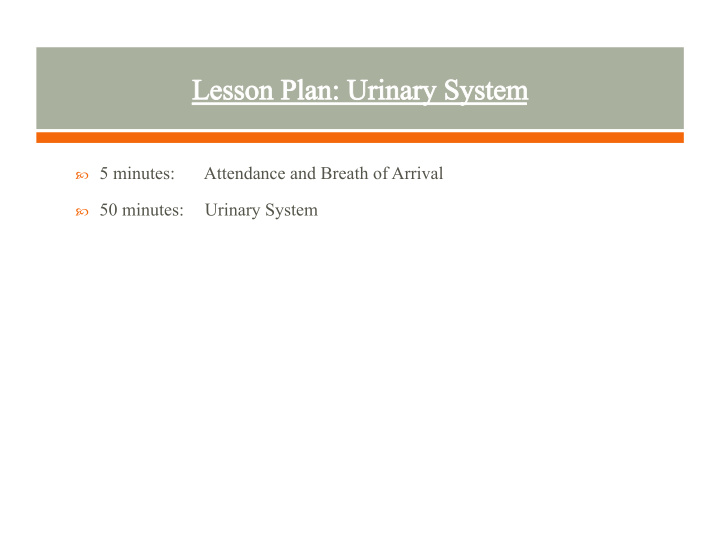



5 minutes: Attendance and Breath of Arrival 50 minutes: Urinary System
Punctuality- everybody's time is precious: Be ready to learn by the start of class, we'll have you out of here on time o Tardiness: arriving late, late return after breaks, leaving early o The following are not allowed: Bare feet o Side talking o Lying down o Inappropriate clothing o Food or drink except water o Phones in classrooms, clinic or bathrooms o You will receive one verbal warning, then you'll have to leave the room.
YouTube Link “One doesn’t discover new lands without consenting to lose sight of the shore for a very long time.” –Andre Gide
Cells of the body metabolize nutrients, producing wastes such as nitrogen, ammonia , and urea which are toxic to the body. Other substances also accumulate as a result of metabolic activities: sodium chloride, sodium sulfate, phosphate, hydrogen molecules, and ions.
All of these waste materials must be excreted from the body for homeostasis to be maintained and for metabolism to function optimally. Several systems contribute to waste elimination – respiratory, integumentary, digestive, and urinary .
The kidneys within the urinary system filter the waste products from the blood and produce urine. It travels through the ureters and down to the urinary bladder, which contains it until expelling it out of the body through the urethra.
Kidneys Ureters Urethra Urinary Bladder
Eliminates wastes and foreign substances Regulates chemical composition of blood Regulates blood pH Regulates blood volume and fluid balance Regulates blood pressure Maintains homeostasis
Kidneys Principal organs of the urinary system located in the upper lumbar region. They process blood and form urine to be excreted.
Renal cortex Outer region of the kidney where the nephron's glomerulus and Bowman's capsule are located.
Renal medulla Inner region of the kidney where the nephron's loop of Henle is located.
Nephron Kidney's filtering unit. Parts: glomerulus, Bowman's capsule, renal tubule .
Glomerulus In the nephron, a small ball of fine capillaries within the Bowman's capsule. Bowman's capsule Hollow cup-shaped mouth of a nephron.
Filtrate Resulting fluid filtered from the blood in the nephron of the kidney. After processing it becomes urine. Renal tubule Small tube within the nephron through which filtrate flows as it is being processed. Subdivided into proximal and distal tubule and the loop of Henle. Collecting duct Structure made up of the distal tubules of several nephrons. Joins several larger ducts to become the renal papilla.
Renal papilla Structure made up of multiple collecting ducts that join together. Calyx (pl. calyces) Cup-like structure protruding from the renal papilla in the kidney. Minor calyces join to form a major calyx that leads to the renal pelvis.
Renal pelvis Large urine collection reservoir within the kidney. Forms the upper region of the ureter.
Bowman's capsule → Renal tubule → Collecting duct → Renal papilla → Minor calyx → Major calyx → Renal pelvis → Ureter
Juxtaglomerular apparatus Structure within the kidney that assists in maintaining blood pressure. Consists of juxtaglomerular cells and macula densa. Juxtaglomerular cells Structure in the nephron that monitors blood pressure and secretes renin when blood pressure drops. Macula densa Structure in the nephron that senses the concentration of filtrate and responds to a decrease in sodium by releasing prostaglandins .
Renal artery → Afferent arteriole → Glomerulus → Efferent arteriole → Peritubular capillaries → Renal venule → Renal vein → Inferior vena cava
Step 1: Filtration Water and small solids in the blood pass through the filtration membrane and enter the Bowman's capsule. Proteins and blood cells remain in the bloodstream.
Step 2: Reabsorption 99% of the filtrate is reabsorbed back into the blood stream.
Step 3: Tubular secretion Before filtrate leaves the body as urine, a final adjustment to the blood composition is made. These tubular secretions rid the body of toxic compounds to regulate blood pH .
Ureter Slender hollow tube transporting urine formed by the kidney to the urinary bladder .
Urinary bladder Hollow, muscular organ that is a storage reservoir for urine. Located in the pelvis behind the pubic symphysis.
Urethra Narrow tube that transports urine from the urinary bladder out of the body during urination.
Urine Concentrated filtrate from the kidneys that is 96% water and 4% dissolved wastes. Micturition (AKA: voiding) The act of urination.
Fluid balance Antidiuretic hormone (secreted by the pituitary) and aldosterone (produced in the adrenal cortex) regulate the balance of water in the body.
Fluid imbalance Dehydration can occur when water is unavailable or with severe diarrhea or vomiting and excessive sweating. Turgor Skin resiliency , which decreases during dehydration. Edema Abnormal accumulation of fluids in body tissue
YouTube Link “One doesn’t discover new lands without consenting to lose sight of the shore for a very long time.” –Andre Gide
Recommend
More recommend